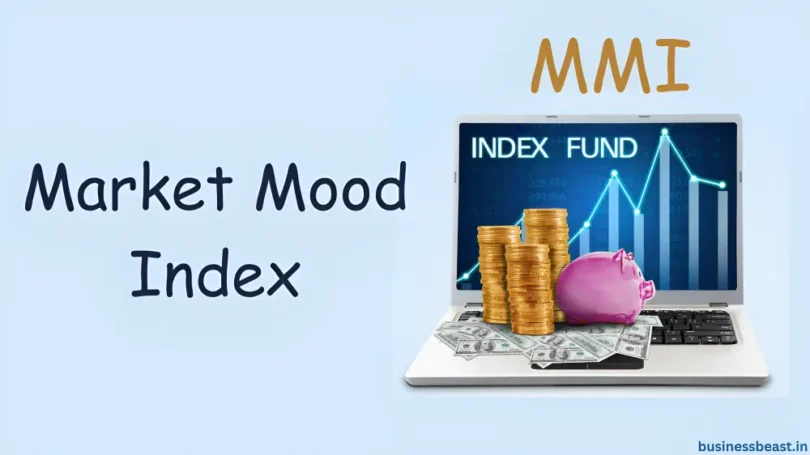The Market Mood Index (MMI) shows how generally bullish or bearish the market is feeling. The Market Mood Index is one measure of the overall state of the stock market. Investors wishing to gauge the overall sentiment of the stock market and make wise investing decisions may find the Market Mood Index to be a useful tool. With a score of 50, it indicates a neutral feeling in the market.
A bullish sentiment score of more than 50 reflects investors’ optimism on the market. Conversely, a score of less than 50 denotes a bearish mood among investors, indicating their pessimism. On the other hand, experts employ seven distinct indicators, such as junk bond demand, market volatility, and stock price momentum, to produce the Fear and Greed Index (FGI), a prominent metric used to gauge investor emotion in the stock market. On the other hand, a score higher than 80 is regarded as being in the “extreme greed” zone.
How to Interpret the Market Mood Index?
Investors attempting to negotiate the intricacies of the financial sector must comprehend the sector Mood Index India (MMI). Market sentiment is mostly determined by the MMI, which is a key indication of sentiment on a numerical range from 0 to 100, where 50 symbolizes neutrality. Scores above 50 indicate optimism and bullish sentiment, while scores below 50 indicate pessimism and a pessimistic market view.
The MMI can be used by investors, including stock traders and mutual fund investors, to make well-informed decisions. The Indian Stock Market’s MMI turns into a useful instrument that helps investors match their tactics with the general mood of the market by providing insights into existing attitudes. Investors can make well-informed decisions that are in line with the changing financial landscape by including the MMI in their analysis.
Zones of Market Mood Index
Understanding the Market Mood Index’s (MMI) key zones or parameters helps navigate market sentiments.
Extreme Fear
- A low MMI rating of less than thirty indicates extreme apprehension and is a great omen for a new role.
- Investors may hesitate in erratic markets because of widespread selling. Nonetheless, MMI emphasizes the value of analysis and says that now is the appropriate moment to invest.
- To take advantage of “Extreme Fear” for your gain, take action when the emotion index approaches your expected profit margin.
Fear
- Investor concern is indicated by an MMI in the range of 30 to 50, but the next step relies on the MMI’s direction.
- If there is a shift from greed to fear, it means that market anxiety is growing. Before considering market upturns, investors should wait for Extreme Fear.
- It is advisable to use caution when the market sentiment is in the “Fear” zone. It is important to watch the movement of the market before investing.
Greed
- An MMI trajectory in the range of 50 to 70 indicates illogical market activity by investors.
- The change from Neutral to Greed alerts investors to the increasing market greed and caution when taking on new positions.
- Either book profits when the index reaches your aim to control greed or consider delaying new decisions until the index reaches Extreme Greed.
Extreme Greed
- An MMI above 70 denotes extreme greed and is an indication that the markets are overbought and about to decline.
- Given the high prices now and the potential for a market correction, this is a warning sign for new investors.
- “Extreme Greed” is a red flag that suggests staying away from new investments because there is a significant chance of losing money in a subsequent downturn.
Factors Take Into Account By Market Mood Index (MMI)
The Market Mood Index takes into account several factors, such as economic statistics, company earnings reports, and news articles that affect the stock market. It uses a complex algorithm to assess these data points and determine the overall sentiment of the market.
The Market Mood Index typically displays a value between 0 and 100, with 50 indicating a neutral state of the market. A score higher than 50 indicates an optimistic feeling among investors, while a number lower than 50 indicates a pessimistic outlook.
Using Market Mood Indicator for Investment
The Market Mood Index is a tool that investors may use to assess the general mood of the market and adjust their investment strategies accordingly.
The benefits of the MMI Index India include its ability to quickly and easily assess market sentiment, recognize possible dangers and opportunities, and work well when combined with other analytical tools. Subjectivity, unpredictability, and possible unsuitability for certain investors are among the drawbacks.
Because market sentiment analysis sheds light on investor expectations, it might be useful for stock price prediction.
The Market Mood Index was successfully used during the COVID-19 epidemic, as demonstrated by case studies. Additionally, MMI is used by investors to identify possible openings in the Bitcoin space.
Relying exclusively on the Market Mood Index to make investment decisions carries certain risks and limitations, such as subjectivity, unpredictability, unsuitability for certain investors, and the requirement to utilize it in conjunction with other analytical tools.
Benefits of Using MMI for Investments
- Market Pulse Unveiled: Decode, Decide, and Thrive: Success in the ever-changing world of trading and investing depends on having a firm grasp of the market’s pulse. Though rare, there are occasions when one can profitably defy popular opinion. Presenting the MMI index, an instantaneous barometer of market sentiment and a useful ally for your investment pursuits.
- Empowering Decisions: Historically, technical and fundamental analysis have been the main tools used by traders and investors to make decisions. Nevertheless, because of the many contributing elements and the uncertain nature of returns, these strategies do not ensure success. Without a positive feeling in the market, even deals and investments that appear strong can backfire. The MMI shows itself to be an essential tool, giving participants quick information so they can make wise decisions.
- Deciphering External Impacts: External factors, including changes in the environment, political upheaval, government policies, and election results, have a big impact on how markets behave. Market participants can better understand the impact of these occurrences by using the shifting MMI score as a compass. Investors can tactically move based on real-time emotion indicators, whether they are exiting unfavorable conditions or grabbing bullish possibilities.
Conclusion
The Market Mood Index’s use has grown beyond traditional financial news sources and its accuracy has improved due to the increased availability of data from social media and other sources. Furthermore, improvements in sentiment analysis and natural language processing technology should make the Market Mood Index even more precise and useful. To make better selections, investors need to use it in conjunction with other analytical techniques including technical and fundamental analysis. The Market Mood Index (MMI), like any other financial instrument, will be as successful as the individual who uses it.








Leave a Comment